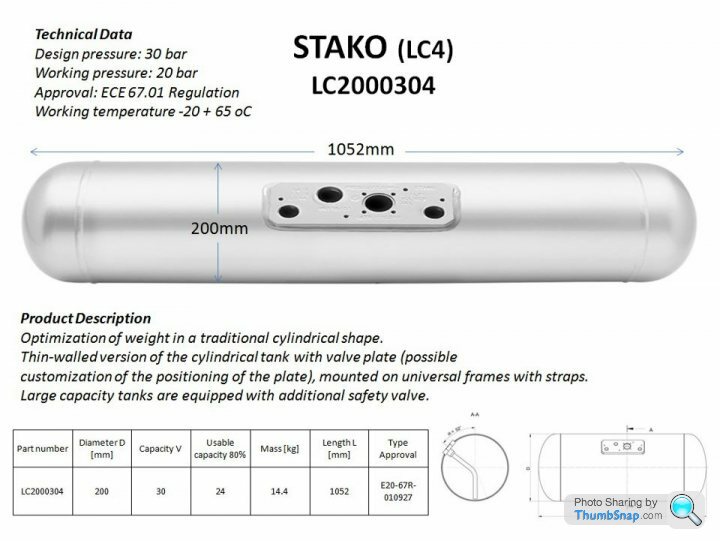LPG Chimaera (Follow My Conversion)
Discussion
My LPG conversion started today.
Follow the progress here as things progress.
The foundation to the conversion is the excellent Canems Dual Fuel engine management system from Lloyd Specialist Developments.
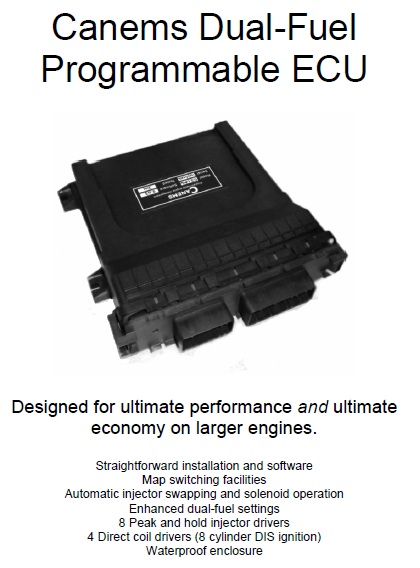
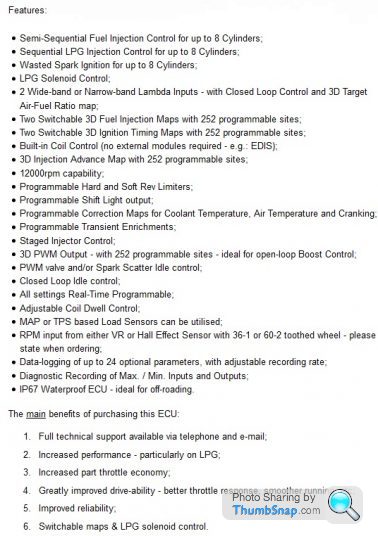
The system has more than proved itself over the last 7 months by delivering excellent improvements in performance & fuel economy on petrol.
So now it's time to explore the next trick up it's sleeve, fully mappable ignition & fuel delivery control on LPG using map 2, no second piggyback ECU needed.
Follow the progress here as things progress.
The foundation to the conversion is the excellent Canems Dual Fuel engine management system from Lloyd Specialist Developments.


The system has more than proved itself over the last 7 months by delivering excellent improvements in performance & fuel economy on petrol.
So now it's time to explore the next trick up it's sleeve, fully mappable ignition & fuel delivery control on LPG using map 2, no second piggyback ECU needed.
Today the EGT sensors went in.
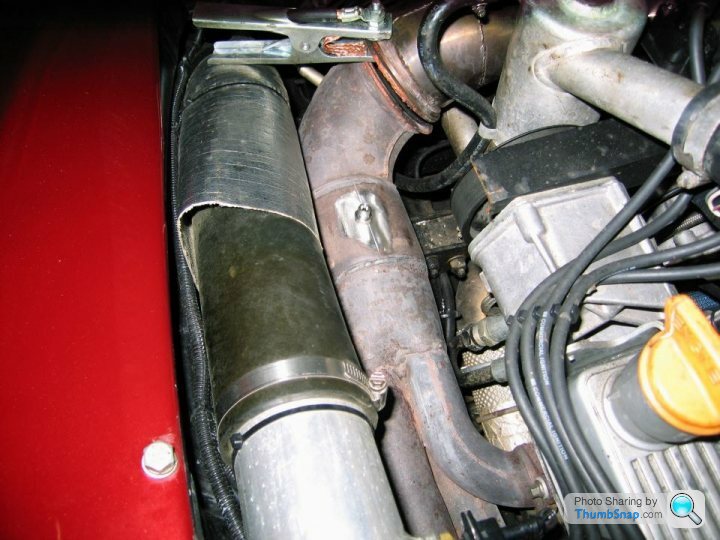
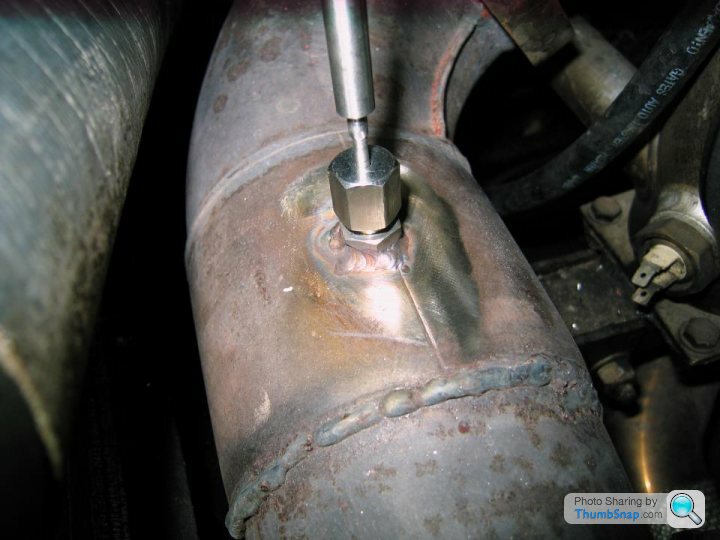
These sensors are connected to the AEM X-Wifi wireless router under the dash that already displays AFR on my IPod Touch or any internet ready browser enabled device.
Exhaust gas temperatures on each bank will be used in addition to the Canems software displaying all the normal sensor inputs, to build the optimum performing safe LPG map.

ETA
Deemed as an advert and therefore removed.


These sensors are connected to the AEM X-Wifi wireless router under the dash that already displays AFR on my IPod Touch or any internet ready browser enabled device.
Exhaust gas temperatures on each bank will be used in addition to the Canems software displaying all the normal sensor inputs, to build the optimum performing safe LPG map.

ETA
Deemed as an advert and therefore removed.
Edited by ChimpOnGas on Monday 25th February 23:28
Edited by Big Al. on Wednesday 13th March 23:55
kwak said:
I'm going to be following this closely, very interested in how it goes.
Where are you planning to put the tank?
The LPG tank arrangement had to be designed around my own very challenging brief:Where are you planning to put the tank?
- To deliver a 300 mile range on LPG
- To offer an additional 150 mile petrol reserve
- To ensure the roof panel can still be stored in the boot as normal
- To retain sufficient luggage space for two people to tour mainland Europe for two weeks while still being able to stow the roof panel in the boot
- To be completely externally invisible & indistinguishable from a standard Chimaera
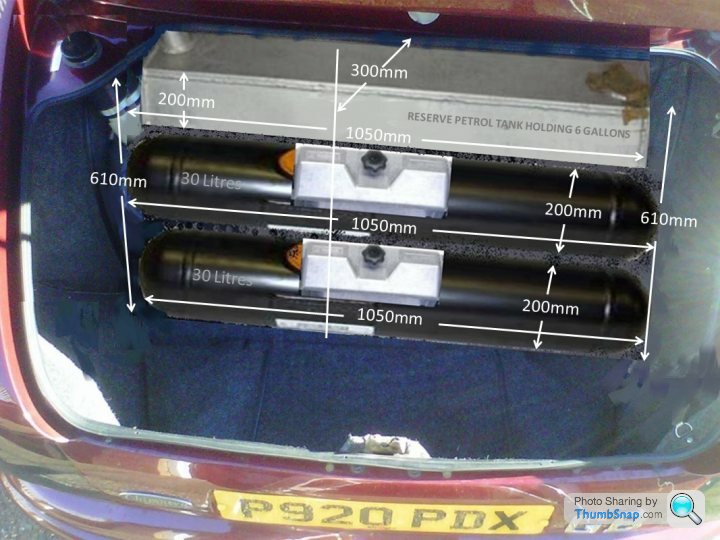
Edited by ChimpOnGas on Tuesday 26th February 08:49
Goaty Bill said:
ChimpOnGas said:
My LPG conversion started today.
You have stopped taking your pills again 

Serious open minded followers of my conversion should also know all the LPG components have been carefully specified to accommodate the phase 2 development.
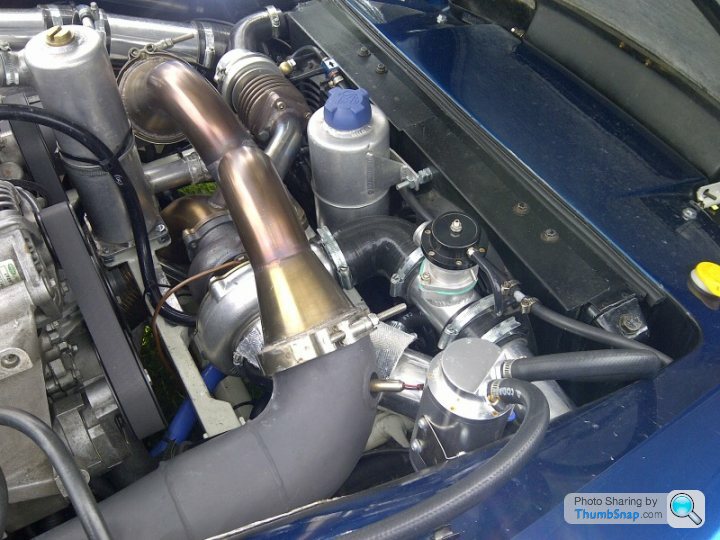
The final objectives for my 4.0 litre Chimaera being:
- To produce 300 rear wheel horse power (375hp at the crank)
- To deliver the cost equivalent of 45mpg at 80mph cruise
- To retain the car's excellent reliability & drivability
But lets not get ahead of ourselves just yet

Look out for the next instalment from ChimpOnGas

Ribol said:
A much better idea than your original executive toy fuel tank arrangement and less likely to make it handle like a fat bird after Xmas 
When I looked at doing the same the tank guy said it would need baffles in it to stop the fuel "slapping around" when cornering due to its proportions.
Did you decide on the LPG filler idea?
Stay tuned Ribol, all will be revealed 
When I looked at doing the same the tank guy said it would need baffles in it to stop the fuel "slapping around" when cornering due to its proportions.
Did you decide on the LPG filler idea?

While you're waiting here's an idea of how the LPG vs Petrol cost equivalents stack up.
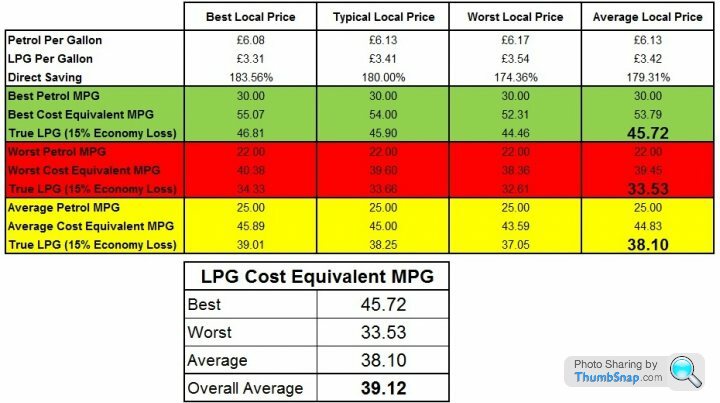
If the compromises can be resolved, who wouldn't want their TVR to average the petrol cost equivalent of 40mpg?
All the evidence suggests LPG can turn your thirsty TVR into your daily driver with no loss of performance or practicality

The Eurotunnel issue troubles me not a jot, we like the ferry.
Ribol is correct however, the true economic evaluation is indeed one that includes the cost of the conversion.
But the fact is the time it takes to recover your investment will be very dependent on how many miles you do annually & the cost/specification of your conversion.
So with everyone completing different annual mileages & having different budgets for the conversion, I've chosen to start off by showing the true LPG vs Petrol cost equivalents.
Using my cost equivalent figures people interested in LPG can easily then apply their own variables to make the decision if a dual fuel conversion is right for them.
They will also need to be honest with themselves on how long they intend to hold onto their TVR.
It's certainly true to say the conversion will only really make sense to those TVR owners that intend to keep their car for many years.
My conversion will take up to 4 years to pay for itself, I fully appreciate that's a very long term investment that may not suit all.
But people need to know there are cheaper ways to convert a Chimaera or Griffith to LPG, you dont have to follow my path.
For example, people may just want to pick some elements of my design to apply to their project, the tank arrangement for instance is generic to the car, not specific to the systems I've selected.
I wholeheartedly encourage people considering an LPG conversion to take what they like from what I'm doing & leave the bits they don't.
Actually as it stands everything I'm doing to try and make a better LPG TVR is still theory, there's nothing to say at this stage that a far cheaper solution won't end up being just as good.
I'll be honest in saying in my case I've tried to innovate & choose the best of everything, and that approach is never going to be the cheapest.
I'm doing things this way because there's more to my LPG conversion than just the savings element, for me it's a fun hobby project too.
It's driven by my positive experiences of LPG, if you like it's an exercise in what's possible if you think outside the box & don't allow oneself to be completely handcuffed to the commercials
Every year we see owners throwing thousands at their TVR to gain a few more horse power, & lets face it a TVR is a hobby sports car so that makes perfect sense, consequently it's an approach that's always accepted without criticism or economic challenge/scrutiny from the group.
So while my project clearly has elements of cost saving around it, I'd ask interested parties not get too hung up on the minutia of economic detail at this stage.
I see it as an interesting & different TVR project to the norm, one that hopefully will prove how these charming & very undervalued cars can continue to compete on all levels with the likes of the very latest Porsche Boxter at a fraction of the cost.
And if you've come this far with me but still don't like the idea of an LPG TVR, I recommend you stop reading now.
Intelligent constructive criticism is always welcomed
However, pointless sniping at a project you don't necessarily agree with can just spoil it for those with a genuine interest in what I'm presenting here.
Wish me luck, Dave.
Ribol is correct however, the true economic evaluation is indeed one that includes the cost of the conversion.
But the fact is the time it takes to recover your investment will be very dependent on how many miles you do annually & the cost/specification of your conversion.
So with everyone completing different annual mileages & having different budgets for the conversion, I've chosen to start off by showing the true LPG vs Petrol cost equivalents.
Using my cost equivalent figures people interested in LPG can easily then apply their own variables to make the decision if a dual fuel conversion is right for them.
They will also need to be honest with themselves on how long they intend to hold onto their TVR.
It's certainly true to say the conversion will only really make sense to those TVR owners that intend to keep their car for many years.
My conversion will take up to 4 years to pay for itself, I fully appreciate that's a very long term investment that may not suit all.
But people need to know there are cheaper ways to convert a Chimaera or Griffith to LPG, you dont have to follow my path.
For example, people may just want to pick some elements of my design to apply to their project, the tank arrangement for instance is generic to the car, not specific to the systems I've selected.
I wholeheartedly encourage people considering an LPG conversion to take what they like from what I'm doing & leave the bits they don't.
Actually as it stands everything I'm doing to try and make a better LPG TVR is still theory, there's nothing to say at this stage that a far cheaper solution won't end up being just as good.
I'll be honest in saying in my case I've tried to innovate & choose the best of everything, and that approach is never going to be the cheapest.
I'm doing things this way because there's more to my LPG conversion than just the savings element, for me it's a fun hobby project too.
It's driven by my positive experiences of LPG, if you like it's an exercise in what's possible if you think outside the box & don't allow oneself to be completely handcuffed to the commercials

Every year we see owners throwing thousands at their TVR to gain a few more horse power, & lets face it a TVR is a hobby sports car so that makes perfect sense, consequently it's an approach that's always accepted without criticism or economic challenge/scrutiny from the group.
So while my project clearly has elements of cost saving around it, I'd ask interested parties not get too hung up on the minutia of economic detail at this stage.
I see it as an interesting & different TVR project to the norm, one that hopefully will prove how these charming & very undervalued cars can continue to compete on all levels with the likes of the very latest Porsche Boxter at a fraction of the cost.
And if you've come this far with me but still don't like the idea of an LPG TVR, I recommend you stop reading now.
Intelligent constructive criticism is always welcomed

However, pointless sniping at a project you don't necessarily agree with can just spoil it for those with a genuine interest in what I'm presenting here.
Wish me luck, Dave.
TVR Stef said:
Regarding your requested 300 mile range on LPG, you have shown 2 x 30L tanks. I've been running LPG for years in my BMW 323i it has a 70L tank but you can only fill them to about 70% and from experience I've only been able to put in 46L which gives me a range of about 260 miles. (The car does approx 32mpg on petrol).
Hope this is so some help.
Thanks TVR Stef,Hope this is so some help.
It's important to understand the challenges of space when converting a TVR Chimaera.
The typical 80% LPG tank fill you refer to is not a legal requirement, it's used as belt & braces fail safe to protect the average driver that has no interest in technical matters.
If appropriately configured, two 30 litre tanks will hold just shy of 60 litres of LPG.
You just need to be sensible, ie don't brim the LPG tanks to 60 litres then go leave the car in the hot sun all day.
The full 60 litre capacity will only be used at the point of departure on a long trip.
Typical driving will see natural fuel consumption providing the equivalent of an 80% fill after just 50 miles or so on the move.
Systems are incorporated to ensure safe venting if required.
I am still left with the choice of either brimming when embarking on big trips, or creating my own 80% fill when preferred.
This is as simple as stopping the fill at 48 litres.
I totally accept 100% fills are not for everyone, but with the application of a little common sense I personally have no issue with the practice.
Other long standing LPG Chimaera owners have proven to have had no issues applying the common sense principle either.
Moving on, lets look at the petrol gauge:
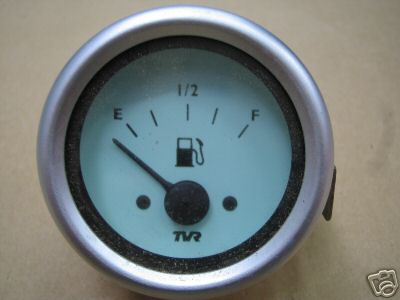
A 200mm petrol sender has been selected to work with the bespoke aluminium reserve petrol tank, the resistance will be trimmed to show a genuine full to empty over the full working range of the existing TVR petrol gauge, reflecting the now reduced 6/7 gallon capacity.
The needle will just fall twice as fast as it does now when running on petrol.
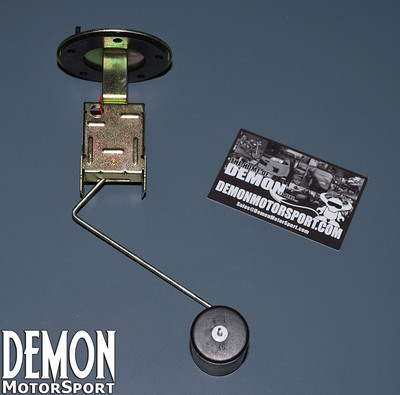
Now lets look at the LPG gauge

Same resistance trimming story as with the petrol sender, the clock will be removed from the dash & replaced with an original matching TVR petrol gauge to display the LPG level.
One of the objectives for my conversion is that it's invisible to the casual observer
Replacing the clock with a second matching TVR petrol gauge to show the LPG level is just one of the little details that helps achieve this goal
More to follow.........

A 200mm petrol sender has been selected to work with the bespoke aluminium reserve petrol tank, the resistance will be trimmed to show a genuine full to empty over the full working range of the existing TVR petrol gauge, reflecting the now reduced 6/7 gallon capacity.
The needle will just fall twice as fast as it does now when running on petrol.

Now lets look at the LPG gauge


Same resistance trimming story as with the petrol sender, the clock will be removed from the dash & replaced with an original matching TVR petrol gauge to display the LPG level.
One of the objectives for my conversion is that it's invisible to the casual observer

Replacing the clock with a second matching TVR petrol gauge to show the LPG level is just one of the little details that helps achieve this goal

More to follow.........
BountyHunter said:
im impressed - obviously a lot of thought has gone into this.
one thing - I recall from my own LPG experiences that you "only" get 80 - 85% ish fill rate.
so prob more like 50 litres in those tanks - but thats still 11 gallons ish.
Thanks for your support of the project BountyHunter, & to others that a have shown me their encouragement.one thing - I recall from my own LPG experiences that you "only" get 80 - 85% ish fill rate.
so prob more like 50 litres in those tanks - but thats still 11 gallons ish.
80% of 60 litres is 48 litres.
I'm working on an average conservative LPG fuel consumption figure of 21mpg.
This is taken as 15% lower than my absolute worst case average brim to brim petrol consumption of 24.4 mpg since I moved to the Canems engine management system.
For those that don't know, this reduction in economy is due to the calorific value of LPG being lower than that of petrol (by weight).
The 15% figure is typical touted within the LPG conversion industry, however there is some evidence (as yet un-proven) that my system may be more efficient than this.
I am reliably informed many LPG systems actually often deliver a 10% reduction in economy or better, & apparently 10% is not outside the realm of possibility on my conversion.
However, as I've already pointed out this is yet unproven, so lets err on the side of caution initially by sticking with the pessimistic 15% economy loss figure.
Right, get ready for some deeply dull maths folks

48ltrs / 4.54 = 10.57 UK gallons
10.57 x 21 = 222 miles on LPG
My design brief states a 300 mile LPG range.
So to achieve my 300 mile range we can work the calculation back like this:
300 / 21 = 14.28 UK gallons
14.28 x 4.54 = 65 litres of LPG required
At a 100% fill of 60 litres I should actually see:
60 x 4.45 = 13.21 gallons @ 21 mpg = a 277 mile range
So it already looks like I've missed my target range by 23 miles even on a 100% fill

Please read my comments above on the 80% fill rule, at the end of the day it's personal choice to exceed 80%.
Compromise exists within any design, however in this case I believe it will be the application of common sense that will deliver my requirements in perfect safety.
The good news is the times I really need that 300 mile range is when I'm touring, & long motorway trips at 80mph should actually deliver a real world figure of 25.5mpg on LPG even using the pessimistic 15% calorific loss equation.
This changes everything:
300 / 25.5 = 11.76 UK gallons (or 53.4 litres) of LPG required to meet my 300 mile range brief
So you see folks, it all depends on how efficiently we can get the engine consuming LPG.
If we achieve a 10% economy loss not the pessimistic 15%, then she'll be consuming LPG at 27mpg at a steady 80mph.
300 / 27 = 11.11 UK gallons (or 50.44 litres) of LPG required to meet my 300 mile range brief
TBH I suspect it'll be close but no banana on the whole 300 mile range objective.
But then again something in the order of 270 miles is still a very practical touring range to my mind.
Only time will tell

Edited by ChimpOnGas on Tuesday 26th February 15:08
jojackson4 said:
After running a LPG transit for ten years no problems with maxing the tank the pump stops come rain or shine a full 16days of sun in the ten years
Pretty sure the tanks have some kind of pressure release or expansion built in for the 4 hot days a year we get
BRIM A WAY
I was always 5L short of full when the pump stopped unless it was very cold (most of the time) and you got an extra 2L in
Running a diesel transit now and running costs have gone up a1/3
Crack on mr chimp it's worth it
Good post, I like input like this from real world LPG users Pretty sure the tanks have some kind of pressure release or expansion built in for the 4 hot days a year we get
BRIM A WAY
I was always 5L short of full when the pump stopped unless it was very cold (most of the time) and you got an extra 2L in
Running a diesel transit now and running costs have gone up a1/3
Crack on mr chimp it's worth it

There's a nice chap over on the Wedge forum called John "Gaswedge" that I'd like to see join in here.
I know he's done many thousands of happy cheap LPG miles over quite a few years in his converted RV8 Wedge, and there's at least two LPG Chimaera's that I'm aware.
Not to mention "pjac67's" very powerful Emerald equipped & recently converted Griff too.
jojackson4's comments support what I've heard from others, with care & common sense we needn't demonise the 100% fill.
For those that don't understand what's going on, the valve is in your tank not the forecourt pump, the pump doesn't know how big your tank is, and the petrol station wants to sell you as much LPG as they can.
So why & how would the pump know to stop at 80%, like I say the cut off valve is in your tank, and it can easily be adjusted just like the ball cock on your water tank.
But I don't want to get bogged down on fill levels, you can see all my calculations above if this is your special interest.
One thing is for sure though, packaging is the issue, carrying enough gas to get a good range while still retaining sufficient boot space to take the roof panel & plenty of luggage is the biggest challenge of all.
You will always be restricted in the size of tanks you can fit in, even a few extra litres of LPG held in those tanks can make the difference between a practical conversion & one that annoys you because you're forced to constantly keep filling up.
I'm confident 270 miles is enough, but I'm still pushing for my 300 mile target, however it ends up lets not forget I've still got 150 miles of the devilishly expensive liquid fuel on board as a backup.
Thanks again for everyone's words of encouragement, I'm glad I'm not alone in seeing the potential benefits of running a TVR on LPG.
Look out for my next instalment

SILICONEKID350HP said:
You must be buying masive LPG injectors for the Turbo .
The turbo is a way off yet Daz, but the vaporiser allows for boost reference & has ample capacity to feed the blown engine.You're right though mate, injectors are a different story.
Injectors do exist to do the job no problem, but I'm not keen on fitting the Keihin 100cc Brown Dots needed if it means my current normally aspirated set up can't be made to idle nicely.
In its normally aspirated guise, we're far better off using the Keihin 63cc Orange Dots.
Eight of these world class LPG injectors should give me a nice smooth idle with capacity to supply an engine producing up to 288HP.
Thats small change in your world Daz, but more than sufficient right now for my little normally aspirated 4.0 litre Gas Bag.
One step at a time me old mate

Edited by ChimpOnGas on Tuesday 26th February 20:15
Update, the original petrol tank is out to make way for the LPG tanks & bespoke auxiliary petrol tank.
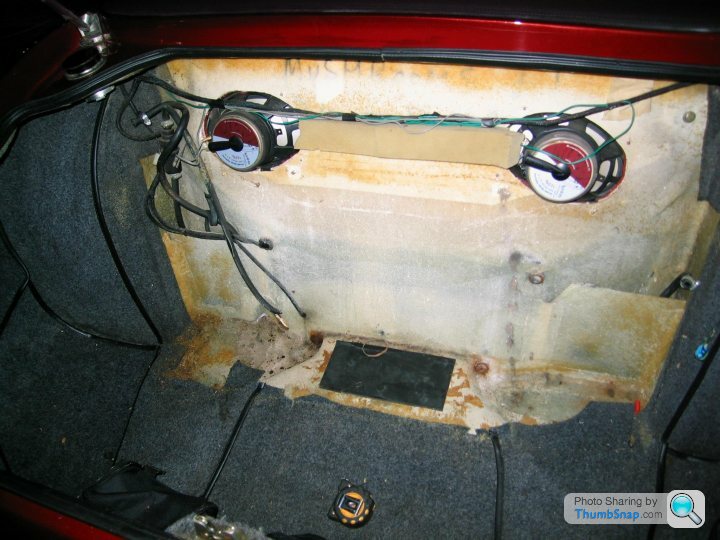
The stainless steel bracket fab work is well under way.
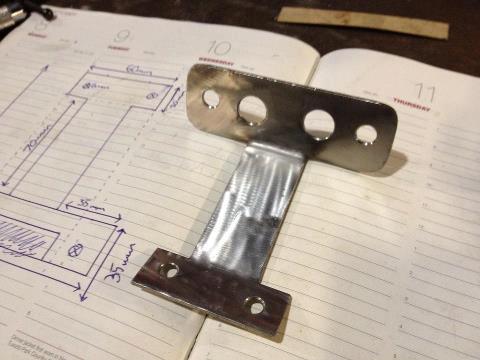
Readying the injectors
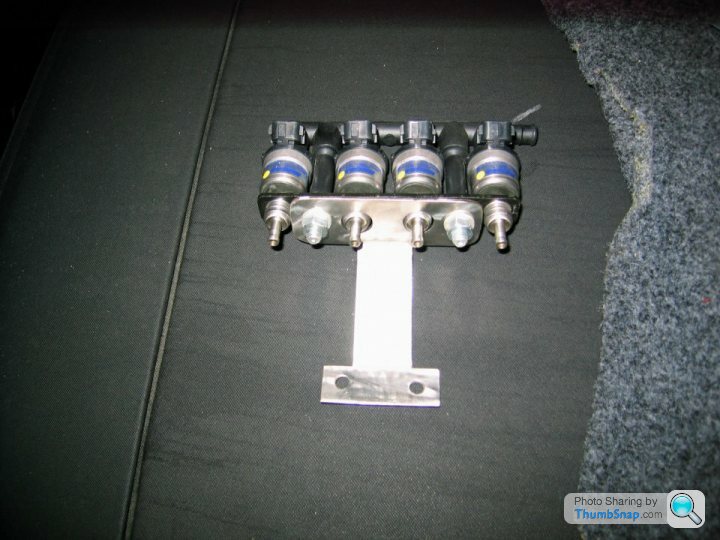
And positioning making use of original fixings
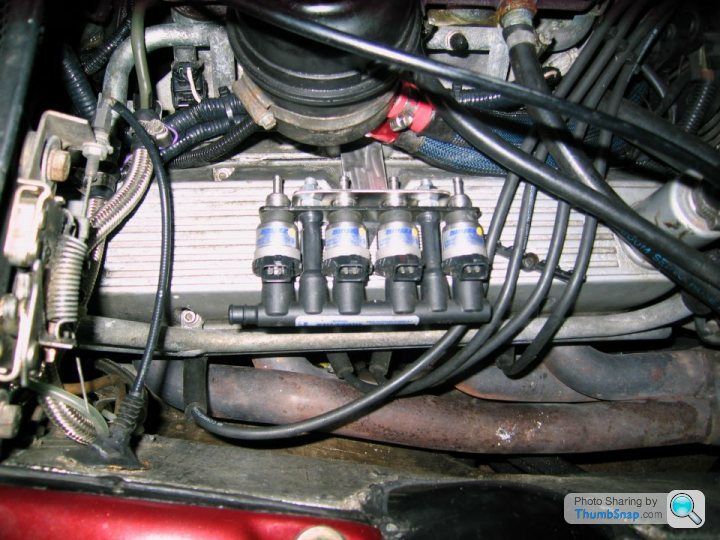
Tomorrow is drilling & tapping for the injector nipples, pipework fitting too.

The stainless steel bracket fab work is well under way.

Readying the injectors

And positioning making use of original fixings

Tomorrow is drilling & tapping for the injector nipples, pipework fitting too.
SILICONEKID350HP said:
I discussed an LPG conversion with a local installer ,he told me it needs a cage around it because it`s a fibreglass car ..
What about insurance ?
The tanks will be securely bolted to the rear of the chassis.What about insurance ?
TVR kindly provided four perfectly positioned & very strong mounting points.

My chosen tank position delivers the best weight distribution & the safest location by far.
LPG tanks are extremely strong, much stronger than the original TVR aluminium petrol tank in fact

Conclusion, no cage required

To answer your second question Daz, I spoke with my insurance company last week & they want £20 as a one-off admin fee to record the change to LPG.
They also confirmed my annual premium will only go up by £20 when I renew my policy in May.
Not the end of the world given the fuel cost savings

Teetertank said:
I have heard that LPG injectors should be mounted vertically. Not sure if this is to prevent build-up of sludge or to ensure wear is even. It's probably a minor point, but seeing as you are going to so much trouble you may want to check if you haven't already.
Thanks for your words of encouragement Teetertank.As one of the first TVR owners to take the plunge & fit LPG to your Chimaera I welcome your input.
You are right about the injector positioning, but there's a bit more to it than just choosing to fit them vertically because is a bit better than horizontal.
Actually the reason vertical is often described as best is not really about sludging, it's more because you typically (but not always) end up with a straighter pipe run this way.
A straight run always being preferable to forcing the gas to turn in it's path from the injector to the inlet manifold.
But it's all a question of packaging, for example the pipe length from the injector to the injector nipple should never exceed an absolute maximum of 200mm.
In fact, way more important than injector orientation is this injector to injector nipple pipe length rule.
And the rule is simple:
"The Shorter The Better"
One of the biggest injector positioning issues on our engine is the physical plenum chamber design, it's one sided layout does ultimately hinder you achieving an ideal symmetrical injector layout.
So faced with these challenges a compromise must be sought.
Coming back to the maximum 200mm injector to injector nipple pipe length rule, you are actually far better off laying the injectors on their side if this means your pipe length can be made shorter than if you had mounted them vertically.
Essentially the "shorter the better" rule overrides the preferred "nice to have" vertical positioning.
At the end of the day vertical injector positioning is preferable but by no means essential.
It's well accepted within the LPG conversion industry that the Keihin LPG injector exists in a class of it's own.
Keihin injectors are of such high quality they do not suffer the same orientation issues as lesser injectors do, read the LPG forums for any length of time & quickly you'll discover that not all LPG injectors are created equal.
With the application of a very high quality & effective Prins LPG filter & the Keihin injector's own internal filters, the build up of LPG residue in the injector becomes more or less a non-issue.
As with any machine or system, following the correct maintenance schedule is essential to maintaining perfect reliability.
With every design there will be small compromises, in this case horizontally mounted injectors with shorter delivery pipes, beat a vertically mounted injector with longer delivery pipes every time.
But we continue to look at these things, there's no blue print for a conversion like this, it's very much a bespoke design.
If opportunities to do things better present themselves, they will be taken.
In fact I've already designed a cost effective dual plane inlet manifold that will deliver improvements in petrol performance & drivability yet allow for improved injector positioning so these benefits can also be enjoyed when running on LPG.
But that's all part of phaze 2, & probably a good six months off TBH.
Lets get her running nicely on LPG using the existing single plane manifold first.
DAY THREE 
Injectors plumbed in.
You can just see the 4mm i/d pipes going to each port, all 8 pipes are kept to a similar length.
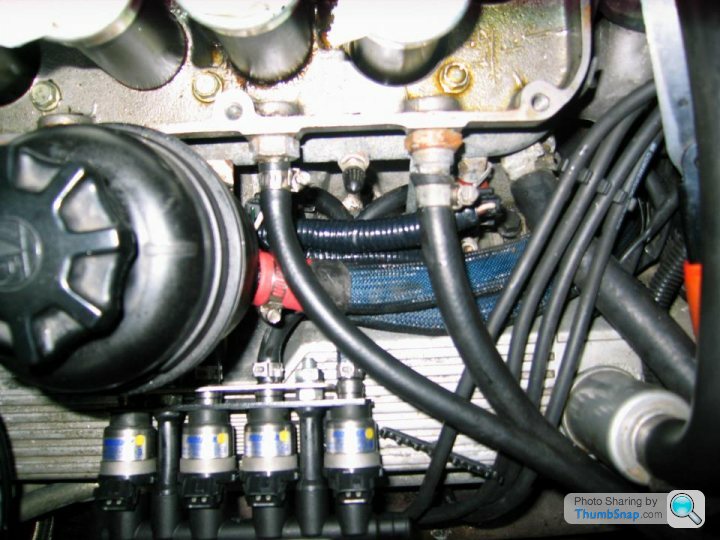
Injector nipples drilled and tapped as close to the petrol injectors as poss, more best practice in the pursuit of the the best efficiency.
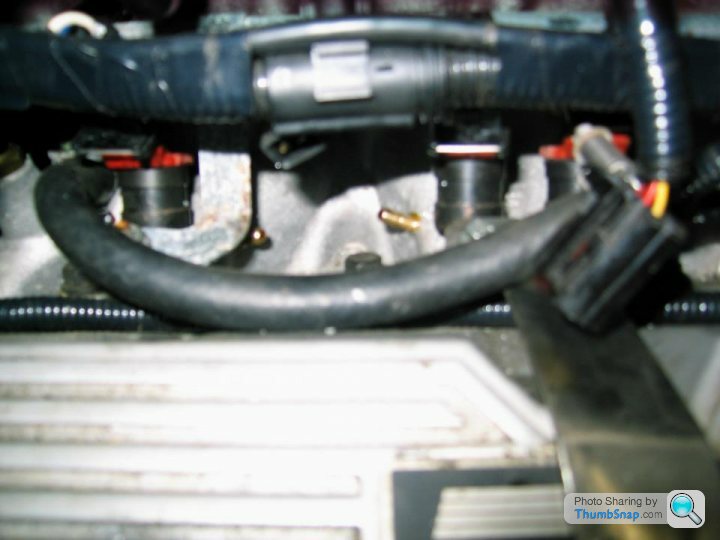
The vaporiser is bolted to the front chassis top rail with 3x 8mm rivnuts, the bracket is made from sheet stainless and also doubles up as a heat shield for the solenoid.
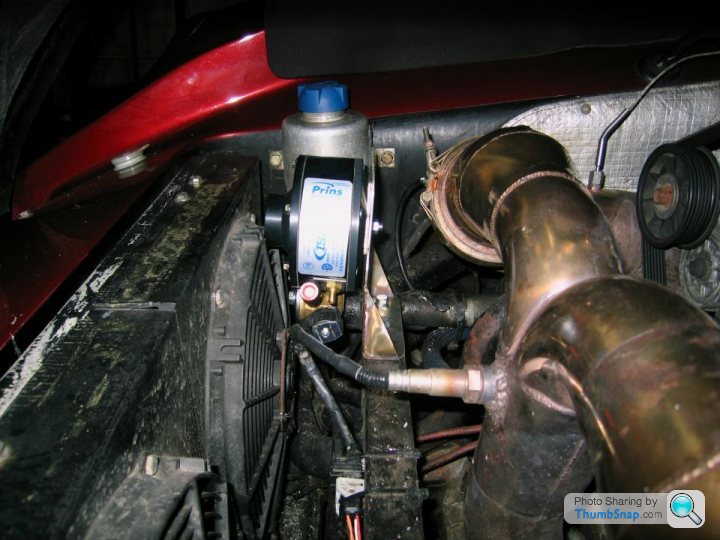
Water feed and return pipe elbows visible, the feed and return pipes will follow the inner wing and be securely fixed using the original rivet holes.
Both pipes will be heat shielded.
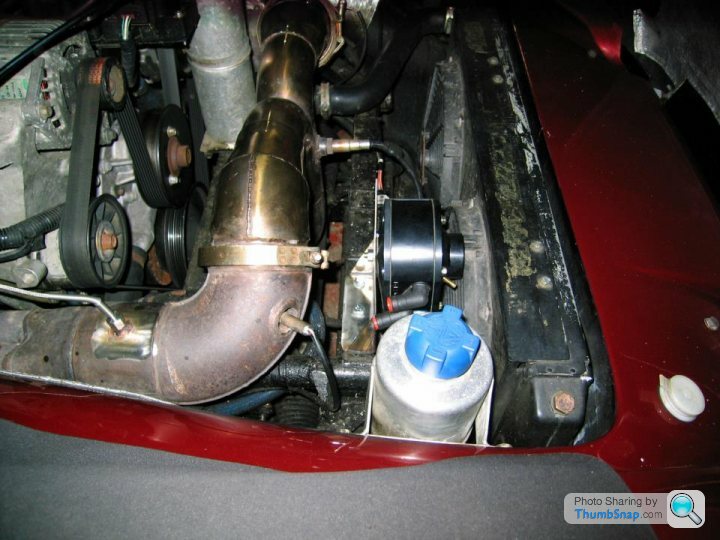
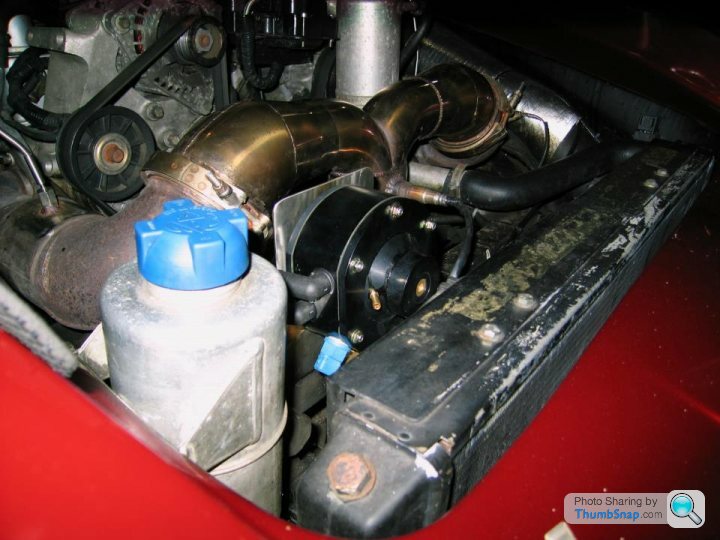
Tune in for tomorrow's update.

Injectors plumbed in.
You can just see the 4mm i/d pipes going to each port, all 8 pipes are kept to a similar length.

Injector nipples drilled and tapped as close to the petrol injectors as poss, more best practice in the pursuit of the the best efficiency.

The vaporiser is bolted to the front chassis top rail with 3x 8mm rivnuts, the bracket is made from sheet stainless and also doubles up as a heat shield for the solenoid.

Water feed and return pipe elbows visible, the feed and return pipes will follow the inner wing and be securely fixed using the original rivet holes.
Both pipes will be heat shielded.


Tune in for tomorrow's update.
320touring said:
I take it the Fans for the rad wont draw enough air to make the vapourisor too cold to function effectively?
in my LPG car, the vap is at the back of the engine bay- out of the majority of the airflow through the engine bay?
Just asking
Radiator fans work by drawing cold air from the front of the car through the hot radiator, therefore the resultant expelled air blowing over the vaporiser is hot not cold.in my LPG car, the vap is at the back of the engine bay- out of the majority of the airflow through the engine bay?
Just asking

There is absolutely no possibility of the Vaporiser freezing up from the effects of being blown with hot air, quite the opposite in fact.
A vaporiser is far more likely to freeze due to cold air from outside the car rushing over it when the vehicle is at speed.
This is resolved by virtue of the vaporiser's water jacket; heated engine coolant is circulated through the vaporiser's water jacket completely eliminating freeze ups.
That's why the car will be started on petrol, within just a few minutes/miles the coolant circulating through the vaporiser will have been sufficiently warmed by the engine to allow the switch over to LPG without risk of vaporiser freezing.
Of course the fundamental reason vaporisers are susceptible to freeze ups is because the vaporiser is where the compressed liquefied gas is allowed to return to its natural gaseous state.
The by product of this process is a massive drop in temperature, think about spraying deodorant from an aerosol, it's cold isn't it.
In each example it's working just like your refrigerator does at home, any compressed gas that's allowed to escape will create a fall in temperature at the point of release.
That's why you need that water jacket, and a ready supply of hot coolant to counter the freezing effects of the expanding liquefied gas.
Actually the only potential issue with our chosen vaporiser position is it's proximity to the exhaust Y Piece which has the potential to overheat the vaporiser, this issue has been resolved by the fabrication of a stainless steel heat shield.
The absence of any catalytic converters on my engine also ensures a dramatic reduction in under bonnet temperatures when compared with standard three cat strangled set up that the car left the factory with.
In summary, I think it'll be just fine

Edited by ChimpOnGas on Thursday 28th February 12:31
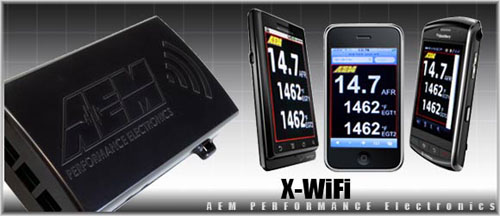
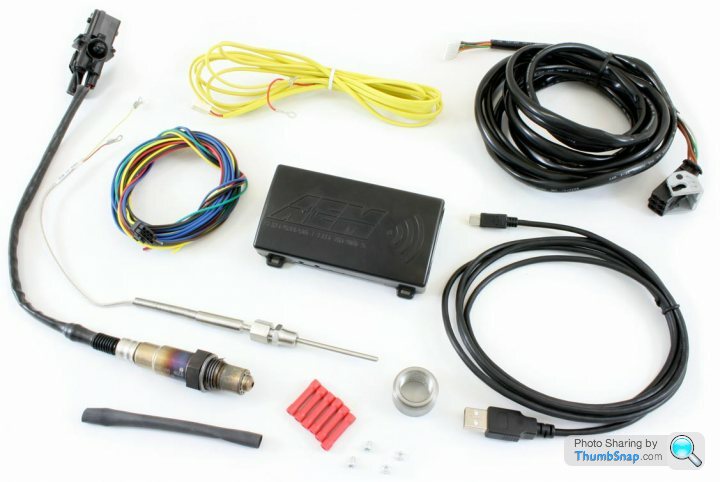
For those of you interested in the benefits of tuning using exhaust gas temperatures, here's a quick basic overview.
http://thesensorconnection.com/applications/egt-pr...
It's important to stress EGT is nothing more than another useful piece information to assist mapping.
IT IS COMPLEMENTARY TO AFR, NOT A REPLACEMENT FOR IT.
Tank trial fit, a perfect fit between the wheel arches
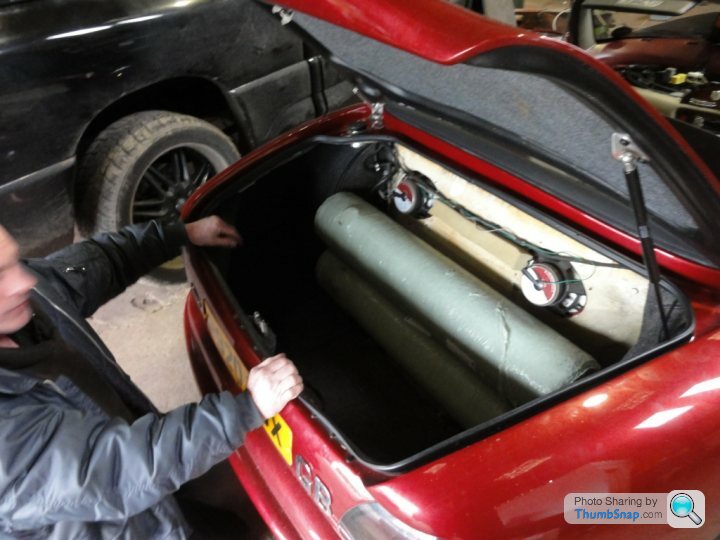
Now with the valve boxes fitted lets try the roof panel in the boot, perfect
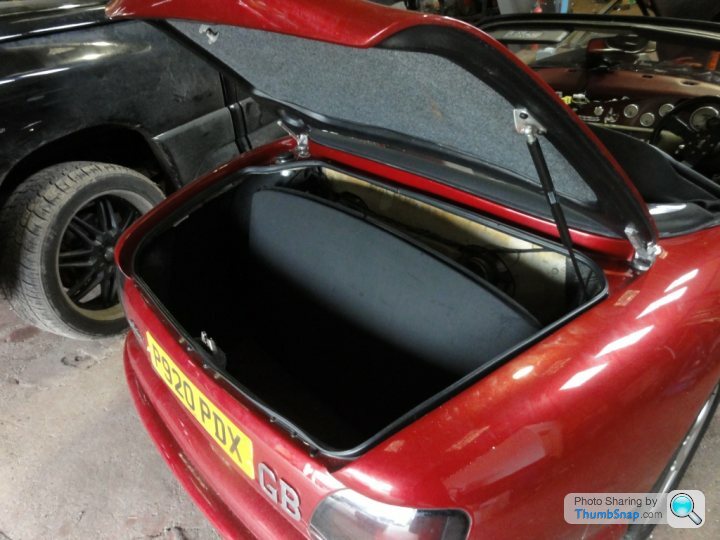
How about roof off touring, will there be enough luggage space?
Again, no problems whatsoever.. and you can see the room for the petrol tank that we are happy now will hold the desired 7 gallons. Happy days
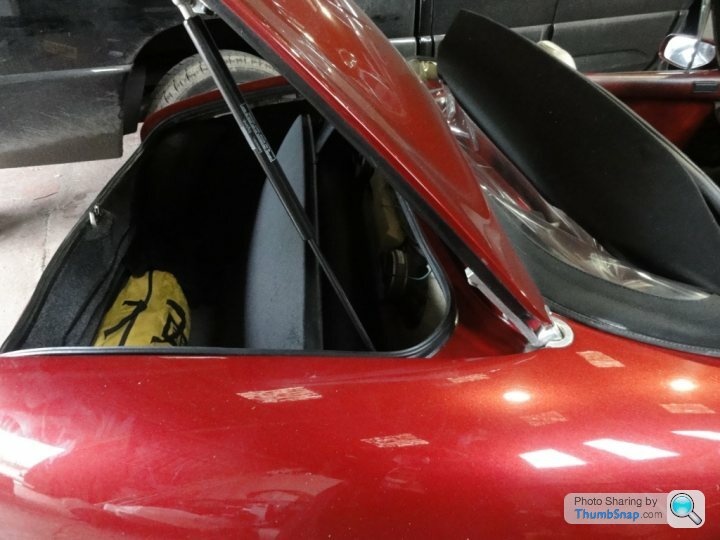
Symmetrical injector positioning fitted flat on top of the rocker covers, & they will operate just as well like this as vertically mounted. Very neat & tidy
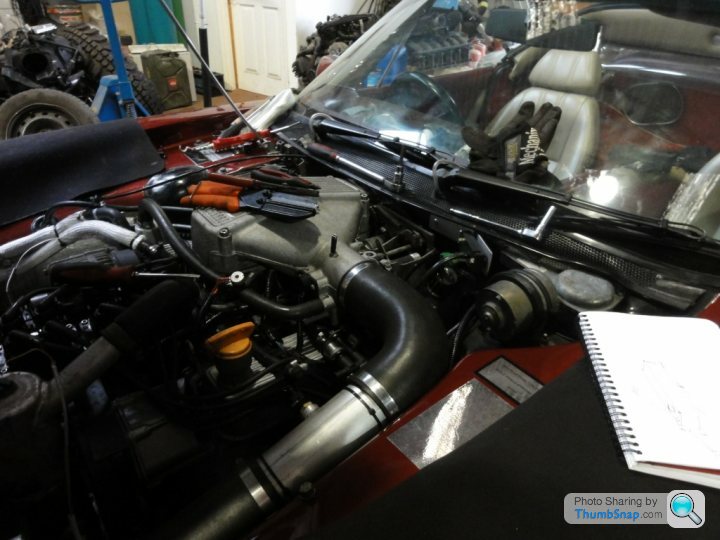
Dash off, clock out & in goes the second petrol gauge to show the LPG level. Some electricary needed to match the petrol & LPG gauges. All part of the stealth approach
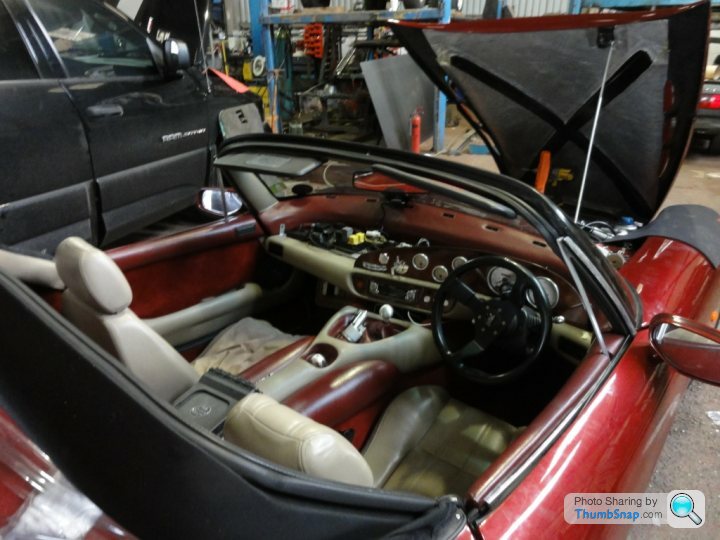
Real world confirmation all my theory & calculations were correct, & all the key issues around converting a Chimaera to LPG resolved.
A very rewarding day indeed

Now with the valve boxes fitted lets try the roof panel in the boot, perfect


How about roof off touring, will there be enough luggage space?
Again, no problems whatsoever.. and you can see the room for the petrol tank that we are happy now will hold the desired 7 gallons. Happy days


Symmetrical injector positioning fitted flat on top of the rocker covers, & they will operate just as well like this as vertically mounted. Very neat & tidy


Dash off, clock out & in goes the second petrol gauge to show the LPG level. Some electricary needed to match the petrol & LPG gauges. All part of the stealth approach


Real world confirmation all my theory & calculations were correct, & all the key issues around converting a Chimaera to LPG resolved.
A very rewarding day indeed

SILICONEKID350HP said:
Whats the maximum HP the vapourisor can cope with ? Teetertank has two ,one each side .
I was going through all this again yesterday.My Prins vaporiser will absolutely handle 400hp no problem whatsoever, a second vaporiser is only required when you get above 450hp.
My Keihin 73 cc Yellow dot injectors easily flow 50hp per cylinder, as with the vaporiser you only need to move up to the brown 100 cc when you exceed 55hp per cylinder (440hp in a V8).
With the turbo delivering 9psi, I'll be gunning for 375hp at the crank (300 RWHP) so both the vaporiser & injectors are well within spec.
If you're still left in any doubt over the capability Keihin 73 cc Yellow dot injectors, here's another interesting LPG project.
Same Keihin 73 cc Yellow dots, this time 10 of them, end result?
505hp & over 600 ft/lbs of torque on LPG.
505 / 10 cylinders = 50.5hp per cylinder.... 50.5 X 8 = 404hp
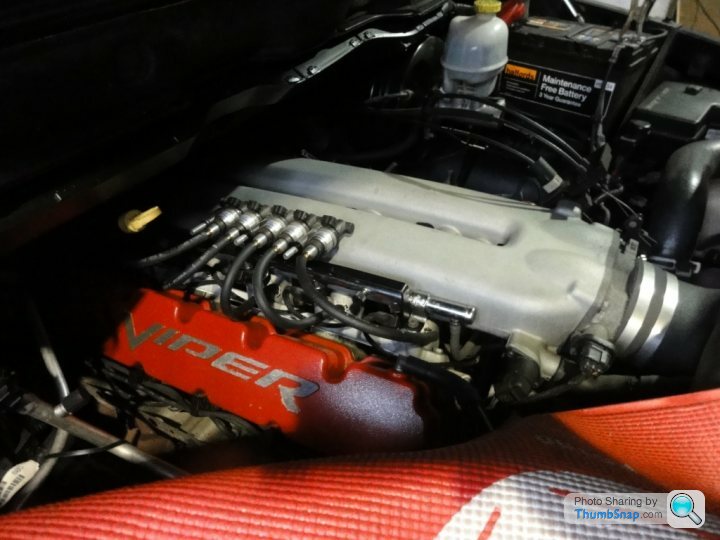
However, with 505hp this one does need two vaporisers.
Gassing Station | Chimaera | Top of Page | What's New | My Stuff





